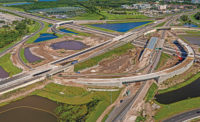A construction project in the Aleutians is no paradise. The remote island chain off the Alaskan coast has become well known for its dangerous high seas and unpredictable weather through the popular reality television show "Deadliest Catch." However, the Alaska Dept. of Transportation, or ADOT, took up the challenge when the state decided the growing Aleutian island of Akutan deserved an airport.
Akutan is the site of a large seafood processing plant that operates year round and employs more than 900 workers. Boats and small seaplanes are used to transport people and cargo, but island and state officials have long sought to build an airport to allow larger payloads.
"The problem has always been the topography of Akutan," says Sean Holland, project manager for ADOT. "It's just too mountainous, and it was finally decided that an airport on Akutan wasn't feasible."
Although an Akutan airfield was finally ruled out, planners looked across the bay to the uninhabited and flatter island of Akun, six miles away. Transporting people and goods between the islands would require a shuttle system of large, 90-ft hovercraft designed to travel in the extreme conditions around the islands.
Slow Start
ADOT contracted with Kiewit to begin construction operations on the $55-million project during the short Alaskan spring and summer; work started in March 2010. Construction equipment had been transported from Seattle to nearby Dutch Harbor, where the "Deadliest Catch" fleet is based, and was ready to be moved to the shallow beach at Akun on landing craft. Crews used the timing of the tides to land the heavy equipment as high up on the beach as possible.
The original plan was to have an Akutan-based team transport the equipment to prepare an operational base on Akun during the day, then return everybody back to Akutan in the evening.
"Because we were dealing with lots of weather issues, that plan didn't work," says Holland. "We were losing days from our already short schedule, and it was decided to build a camp on Akun, so the staff was spending half the morning getting to the worksite."
Initially, a team of six Kiewit employees armed with bulldozers, drills and a fuel truck stayed on barren Akun Island. They built a two-mile-long access road to the camp from a rock quarry and created a pad for a more permanent camp. By mid-May, they had created a foothold on Akun stable enough for a contingent of 60 workers and more heavy equipment.
The summers of 2010 and 2011 were spent doing "the hard work," says Holland. "The soil has a high ash content, and when you combine it with the water, the main job was getting everything out of the mud and keeping it that way. We've moved about one million cubic yards of soil to build the embankments and ditches we needed to stabilize the soil and get around, and we found some quality rock and got our quarry established."
This summer, construction will focus on the 4,500-ft-long runway, storage buildings and hovercraft facilities on Akun and Akutan.
"By September 1, we should be complete with the entire project," says Holland. "After all of the freezes and thaws and waiting out the winters, I know the crews are ready to be done."




Post a comment to this article
Report Abusive Comment